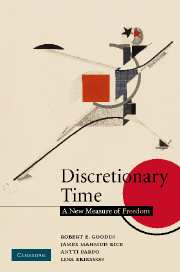Book contents
- Frontmatter
- Contents
- List of figures
- List of tables
- Preface
- Part I Introduction
- Part II Time pressure
- Part III Welfare regimes matter
- 7 How welfare regimes differ
- 8 A temporal perspective on welfare regimes
- 9 Welfare regimes and temporal autonomy
- Part IV Gender regimes matter
- Part V Household regimes matter
- Part IV Conclusions
- Appendix 1 Methodology
- Appendix 2 Data
- Bibliography
- Index
7 - How welfare regimes differ
Published online by Cambridge University Press: 28 October 2009
- Frontmatter
- Contents
- List of figures
- List of tables
- Preface
- Part I Introduction
- Part II Time pressure
- Part III Welfare regimes matter
- 7 How welfare regimes differ
- 8 A temporal perspective on welfare regimes
- 9 Welfare regimes and temporal autonomy
- Part IV Gender regimes matter
- Part V Household regimes matter
- Part IV Conclusions
- Appendix 1 Methodology
- Appendix 2 Data
- Bibliography
- Index
Summary
It has long been a function of the state to promote the welfare of its people. How ‘welfare’ is conceived, and what the state is supposed to do to promote it, has, however, varied widely from place to place and time to time.
After some general remarks on the conceptualization of ‘welfare’ (section 7.1), we offer a very short history of state efforts to promote people's welfare (section 7.2). We then proceed to introduce the three standard ‘welfare regimes’ (section 7.3) and some standard indicators commonly used to situate countries in relation to them (section 7.4). We close with a reminder of ‘other dimensions of welfare’, things that clearly ought to be seen as part and parcel of the welfare state's core activities but which are often left out of such discussions – pre-eminently, for our purposes, child-care policy (section 7.5).
Defining ‘welfare’
‘Welfare’ has both objective and subjective dimensions. Subjectively, ‘welfare’ consists in a state of mind: happiness, or satisfaction. ‘Objective welfare’ – sometimes called ‘standard of living’ – may or may not be related to that. Sometimes ‘objective welfare’ is taken to be simply a list of things that it is objectively good for people to have, whatever their subjective states now or later. That is a ‘hard paternalist’ line. There is, however, a ‘soft paternalist’ line that depicts ‘objective welfare’ as one's capacity (or opportunity) to achieve those subjective states.
- Type
- Chapter
- Information
- Discretionary TimeA New Measure of Freedom, pp. 115 - 130Publisher: Cambridge University PressPrint publication year: 2008
- 1
- Cited by



